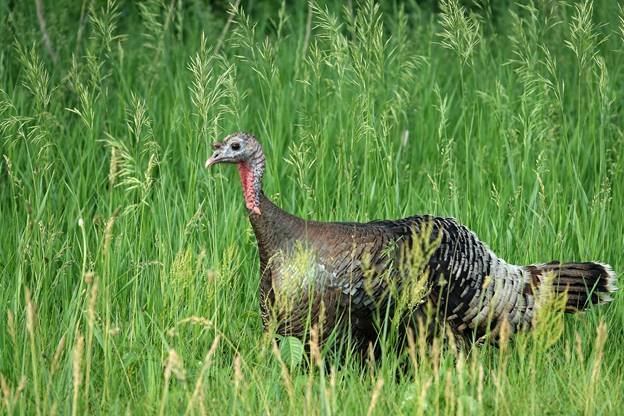June Nature Almanac: Non-Native Smooth Brome May Crowd Out Native Wildflowers
By Stephen Jones and Ruth Carol Cushman
June 2024
After an unusually wet late winter and early spring, the hills west of Boulder appear as green as we've ever seen them. But where are the wildflowers?
Smooth brome (Bromus inermis) was introduced into North America in the nineteenth century with grass seed imported from Eurasia. It has spread throughout the continent, displacing native grasses. An early maturing species, smooth brome can form dense stands long before many native grasses have initiated their spring growth.
Smooth brome (Bromus inermis) is among the easiest grasses to identify. It grows nearly waist high; with long, narrow leaves and oblong, nodding seedheads; and each bending leaf is faintly marked by a crinkly "W" halfway out from the stem. Photo by Steve Jones.
During a recent walk on Shanahan Ridge in south Boulder, we identified 32 species of blooming wildflowers, but we didn't see the profusion of wildflowers that we've observed during previous years. We did notice an unusually lush grass cover dominated by smooth brome.
Many ranchers consider smooth brome a blessing, since unlike our native short grasses which tend to grow in clumps interspersed with bare ground, it forms a lush green cover that is relished by cattle. But in natural areas where it tends to crowd out the native grasses and wildflowers, controlling it has proved challenging. At the Rocky Mountain Biological Laboratory in Gothic, Colorado, various strategies have been tried, achieving mixed results.
Land managers there and at other nature preserves have used mowing, intense grazing, and laying down of black plastic over the smooth brome to inhibit its growth. On some Nature Conservancy preserves, land managers have sprayed herbicides such as Glycosphate on the smooth brome, then tilled the land and planted cover crops, including wheat and oats. After a year or two, native grasses are planted among the rows of dried crops.
Orange arnica (Arnica fulgens) is one native wildflower that appears to thrive in spite of the smooth brome invasion, still forming eye-catching displays on Shanahan Ridge. Photo by Steve Jones.
This procedure has proved effective. It was used a decade ago on 3 acres of a Boulder County Audubon Society preserve in northern Boulder County. That area is still covered by beautiful native grasses, including big bluestem (Andropogon gerardii), Indian-grass (Sorghastrum avenaceum), and green needlegrass (Nassella viridula). However, as people learn more about the potential toxicity of herbicides, their use has fallen out of favor.
Skeptical observers question why we don't just "naturalize" smooth brome. In other words, why don't we accept it as an established species and give up trying to control it. Unfortunately, that approach would most likely transform many of our grassland regions into lawn-like expanses of grass containing limited plant diversity and supporting fewer birds and mammals.
While the dense sod laid down by smooth brome makes attractive resting sites for wild turkeys, these areas of nearly continuous grass cover tend to displace native grasses and wildflowers. Photo by Steve Jones.
On local open space lands, land managers are using short-duration intensive grazing, along with prescribed burning, to reduce smooth brome cover and give native grasses a better chance to thrive. You can see areas within the South Boulder Creek State Natural Area, just south of Boulder, where this approach appears to be working. While smooth brome may comprise the dominant grass cover in late spring, by mid-summer chest-high clumps of big bluestem and Indian grass thrive.
Farther away from Boulder, in areas such as the Pawnee National Grasslands and the Nebraska Sandhills, smooth brome appears to pose less of a problem. This observation suggests that in more extensive and less fragmented grassland areas, native grasses and native wildflowers can still outcompete invasive grasses without human intervention.
Stephen Jones' recent memoir, Nourishing Waters, Comforting Sky: 35 years at a Sandhills Oasis, includes intimate descriptions of interactions among various grasses and their native wildlife populations.
Other June Events
Golden Eagle young begin to fledge from their eyries in foothills cliffs.
Cute and locally threatened Burrowing Owl young emerge from their burrows on the plains.
Wild orchids, including spotted coralroot (Corallorhiza maculata), calypso orchid (Calypso bulbosa), and northern bog orchid (Limmorchis spp.), bloom in wet areas of foothills and mountain canyons.
After evening thunderstorms, the loud "waaaaww" calls of courting Woodhouse toads resonate through marshes on the plains.
Female moose are rearing their young. Avoid walking through dense willows in the mountains, where sightlines are limited. Moose can charge and cause serious injury.






